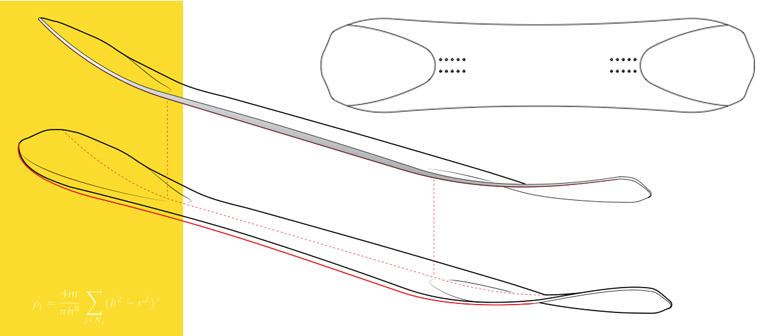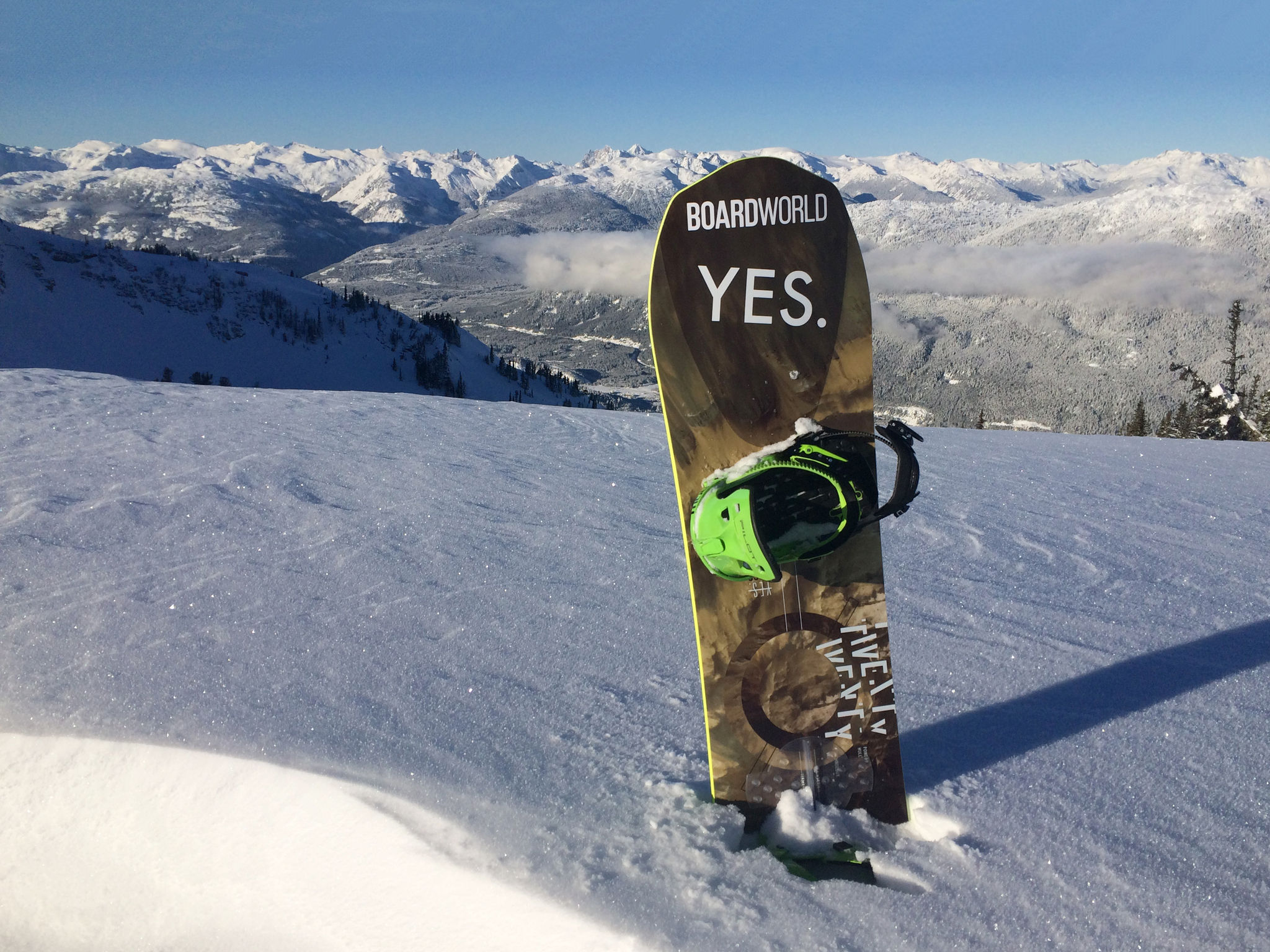Review: YES 20/20 Snowboard
REVIEW: YES 20/20
Rider: Rhys Leitch
Rider weight: 69kg
Boot size: 10 US
Board category: Powder…but maybe more!
Board size: 146cm (no, thats not a joke, keep reading!)
Stance: Centred
Test location: Whistler, Canada
Snow conditions: Powder, Chowder and Groomers
GENERAL REVIEW:
The YES 20/20 is a 2016 model snowboard, and it is one hell of a unique shape.
It’s unique shape comes from the origins of the Yes 420, A short, wide board, its nose and tail shape take their design cues from wakeboard and kite board designs. This board has one thing they don’t, the 3D POWDER HULL. Initially this might sounds like marketing hooha, but trust me, its not. The best way to understand the board shape is in person, but I’ll try my best to describe it: Deep, pronounced concaves dominate both ends of the base - when talking about the nose of the board, this scoops air under the nose, increasing its flotation in powder. The identical concave in the tail disperses the snow out from under it and allows it to sink a little further into the pow. This encourages the board to float like a boat - or like a directional pow board with a setback stance.

The 20/20 base profile is complicated; It combines two profiles together to create the Powder Hull, the centreline of the board is rocker from between the feet, and out at the contact edges it’s a more traditional profile. The combination of these profiles creates the concave at the nose and tail, allowing the board to ride like a directional board in pow, and yet just a super playful wide twin on the groomers.
The board utilizes yes’s “Weightless Core” - The weightless core strikes a critical balance between lightweight and strength. Using a lower density species of poplar in areas that are not as structural and Paulownia in the areas that are, Yes. is able to shave precious weight. This helps a board not only float, but “feel” floaty.
The base is Sintered True – True Sintered bases are harder and more expensive than extruded bases and can be faster for those that ride aggressively fast. But to do that, it needs to be waxed and prepared for conditions.
Now, full disclosure - I own this board, this is how much I’m sold on it. My other boards include a 156cm Endeavour ‘Live’ and a 148cm K2 World Wide Weapon.
The board floats better than my 156cm all mountain, that’s a whole 10cm longer than it! The 20/20 only comes in two size 146 and 150. Deciding which length to ride will depend on your height, weight and riding ability. I’ve ridden it 5 pow days so far, the board continue to impress me - riding terrain has varied from big open face pow lines, tight tree runs and some cliff and cornice drops and the odd kicker in the park ![]() . Conditions have been awesome pow, chunky heavy whistler cement and hard packed groomers.
. Conditions have been awesome pow, chunky heavy whistler cement and hard packed groomers.
I will say that the width of the board took a little adjusting too, it definitely requires more effort to get the board onto its edge (full lay out carving/revert carving is entirely possible). Where it lights up is its ability to whip it around in the sharpest tree turns and pow lines. If you’re considering a board that slays the Pow but you want something twin - This is the board for you.
PERSONAL RATINGS (out of 10):
Best use: Powder
Flex (10 being the stiffest): 5
Carving: 6
Groomers: 8
Powder: 10
Jumps: 7
Jibbing: (not tested. Didn’t want to ruin my pow board on a rail ![]() )
)
Overall: 8.5 (as an pow/all mountain snowboard)
If you have any questions, please don’t hesitate to reply to this thread.
Pics and videos plsss.
I’ve asked this before but I forgot is the board flat or camber?
It’s pretty much flat along the edges, and flat to rocker (nose and tail) through the centreline of the board.
From yesnowboard.com:
3D POWDER HULL
The 3D Powder Hull starts with a base profile that combines 2 distinct rocker lines that, when blended together, create a pronounced base concave in the nose and tail. The centerline is fully rockered starting from the insert packs, all the way to the tips of the bluntly shaped nose and tail. Out at the contact edges is a more conventional base profile that we use on many of our other boards. The resultant concave across the nose and tail acts differently at the leading end of the board than it does at the trailing end when riding in deep snow. At the leading end (nose), the concave draws air under the board – just as a concave spoon-nose does on longboards in the surf – causing lift and floatation. As the snow moves across the base it releases off the tail and the exaggerated rocker line along the center, causes the tail to drop downward.
So even though it’s a perfectly balanced twin, the board rides through deep snow with the same pitch, or planing angle, that we get with directional shapes and set-back stances.
On hard-pack it’s just a short, wide, super fun twin.
Thanks Jez!
Thanks Jez!
probs could have just read the review @skip11 lol
I did. There’s no where in there that mentioned the camber profile. It only says “the centreline of the board is rocker from between the feet, and out at the contact edges it’s a more traditional profile. The combination of these profiles creates the concave at the nose and tail, allowing the board to ride like a directional board in pow, and yet just a super playful wide twin on the groomers.”
Which means there’s rocker from the feet but “traditional profile” at the contact edges. It’s not clear what the overall profile is from nose to tail.
Thanks for the review. I ordered a 420 powder hull last night for Japan this season. Can’t wait to see if it lives up to the hype! ![]()
Hey guys - I hope everyone is having a great spring!!??
I also found the description from YES. a little confusing at first! There is actually the smallest amount of camber between the feet, so it still has (a tweaked version) of our trusted CAMrock profile. The profile that YES talks about being “full rocker” is only from the INSERT POINTS OUT TO THE TIP/TAIL (so NOT between the feet!).
I hope this clears things up - but if not, hit me back if you need any more info!!
Here’s the 20/20 on table. This is what every company needs to do when explaining camber profiles. Just set em down on a table so we can actually see what it’s like. There’s a little camber like Amine said.
So stoked I finally got to ride my new setup. The 20/20 is incredible. Feel free to ask me any questions.

So stoked I finally got to ride my new setup. The 20/20 is incredible. Feel free to ask me any questions.
Can i have it??
So stoked I finally got to ride my new setup. The 20/20 is incredible. Feel free to ask me any questions.
Can Trent have it?????